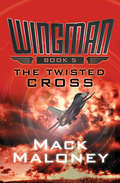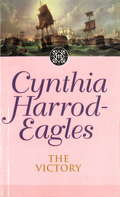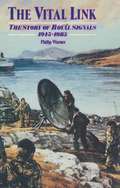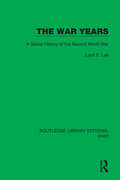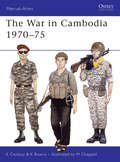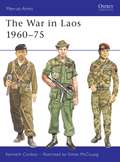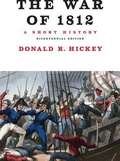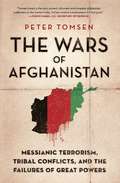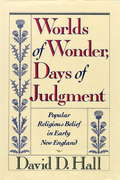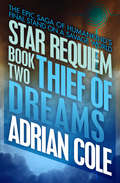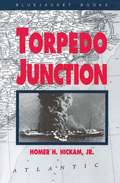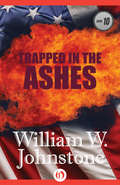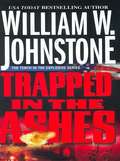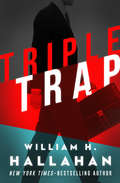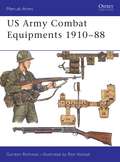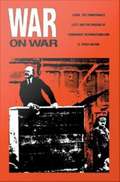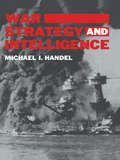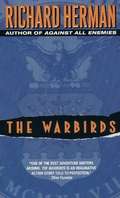- Table View
- List View
The Story of the Vietnam Veterans Memorial (Cornerstones of Freedom)
by David K. WrightThe behind-the-scenes story of how and why the Vietnam Veterans Memorial was built in Washington, D.C.
The Titan Game
by Niven BuschThe rules of the Titan Game are as deadly as gas and as devious as fog: torturers can become esteemed customers, bystanders are seldom innocent, a man's worst enemy is often himself...
The Twisted Cross: The Twisted Cross, The Final Storm, Freedom Express, Skyfire (Wingman #5)
by Mack MaloneyWith the Russians vanquished, fighter pilot Hawk Hunter sets his sights on an old enemy poised for trouble in Panama. A Boeing 727 is making a routine charter flight out of Football City—formerly known as St. Louis—when three F-4 Phantoms appear on its tail and open fire. No match for the lightning-quick Phantoms, the 727&’s pilot is about to give up when his assailants explode in mid-air, becoming the latest casualties of Hawk Hunter, the Wingman. Hunter is the greatest fighter pilot the world has ever known. Most recently, he brought the United States back from the brink of extinction. But a new threat has emerged from the south: An army of neo-Nazis has seized control of the Panama Canal, and they&’re armed to the teeth. Their hateful ideology may be decades out of date, but these jackbooted killers have firepower that is state-of-the-art. The Twisted Cross is the fifth book of the Wingman series, which also includes Wingman and The Circle War.
The Victory: The Morland Dynasty, Book 12 (Morland Dynasty #12)
by Cynthia Harrod-Eagles1803: Napoleon is poised to invade England, with only Nelson's weather-beaten ships in his way, but the French fleet are not the only threat to the fortunes of the Morland family.In the North of England, Mary Ann's relationship with the missionary, Father Rathbone, introduces her to the stark realities of life in plague-torn Manchester.In the South, Lucy's lover, Weston, is assigned to the blockade of Brest, while her neglected husband, Chetwyn, finally finds love in an affair which threatens him with disgrace and ruin.From the fashionable salons of Beau Brummell's London, to the shot-torn docks at Trafalgar, the Morlands face danger and personal tragedy, as well as love and fulfilment.
The Victory: The Morland Dynasty, Book 12 (Morland Dynasty #12)
by Cynthia Harrod-Eagles1803: Napoleon is poised to invade England, with only Nelson's weather-beaten ships in his way, but the French fleet are not the only threat to the fortunes of the Morland family.In the North of England, Mary Ann's relationship with the missionary, Father Rathbone, introduces her to the stark realities of life in plague-torn Manchester. In the South, Lucy's lover, Weston, is assigned to the blockade of Brest, while her neglected husband, Chetwyn, finally finds love in an affair which threatens him with disgrace and ruin.From the fashionable salons of Beau Brummell's London to the shot-torn docks at Trafalgar, the Morlands face danger and personal tragedy, as well as love and fulfilment.
The Vital Link: The Story of Royal Signals, 1945–1985
by Philip WarnerTo maintain the link of communication between battlefields and HQ, between commanders and soldiers, between physically distant Corps is the vital job of the Royal Signal. But the responsibility of the Signals extends beyond the logistical requirements of inter-personal contact Electronic Intelligence and Electronic Warfare are major departments within the organisation, each of which supports the other. The Vital Link examines these diverse aspects and traces the complex developments in techniques, technology and signals tactics since the Second World War. The book, however, is more an historical story then an exhaustive tract for reference purposes. It records the growth of the Signals through its people, the 'high quality' ordinary solder to the odd character, all of whom help to define the Royal Signals. With anecdotes from individual's achievements, both personal and professional, the history of this essentially military branch is presented in an accessible and enjoyable manner.
The War Years: A Global History of the Second World War (Routledge Library Editions: WW2 #42)
by Loyd E. LeeThis book, first published in 1989, combines the broad themes of diplomatic, political and military events with the human dimensions to form a major global analysis of the second world war. It also explains the difficulties encountered by the European powers in mobilising their colonies, and examines the economic and social reorganisation of the belligerents. It shows the impact of the collaboration of occupied peoples with the axis powers, and discusses in detail the resistance movements and the Holocaust. The book also looks at advances in science and technology, the application of social sciences to war, the intelligence services, and the arts.
The War in Cambodia 1970-75
by Kenneth Conboy Mike ChappellThis book examines the uniforms, equipment, history and organisation of the troops that fought in Cambodia in the 1970s. US and Cambodian forces are all covered, including Special Operations, and the course of the war is summarised. Uniforms are shown in full illustrated detail.From the Trade Paperback edition.
The War in Laos 1960-75
by Kenneth Conboy Simon MccouaigAs World War II drew to a close, the Imperial Japanese military seized control of Laos, a French protectorate, and encouraged nationalist movements to forestall the revival of French power in the region. Despite these efforts the French re-entered Indochina and methodically retook the protectorate. By 1957, the government of Laos and the core of the Communist Laotian forces, known as the Pathet Lao, entered an uneasy truce, which plunged the country into 15 years of war. This text explores the resulting war, providing a summary of events and profiling the Laotian government forces, the government Allied forces and the Communist forces.
The War of 1812, A Short History
by Donald R. HickeyThis abridged edition of Donald R. Hickey's comprehensive and authoritative The War of 1812: A Forgotten Conflict has been thoroughly revised for the 200th anniversary of the historic conflict. A myth-shattering study that will inform and entertain students and general readers alike, The War of 1812: A Short History explores the military, diplomatic, and domestic history of our second war with Great Britain, bringing the study up to date with recent scholarship on all aspects of the war, from the Gulf of Mexico to Canada. With new information on military operations, logistics, and the use and capabilities of weaponry, The War of 1812: A Short History explains how the war promoted American nationalism, reinforced the notion of manifest destiny, stimulated peacetime defense spending, and enhanced America's reputation abroad. Hickey also concludes that the war sparked bloody conflicts between pro-war Republican and anti-war Federalist neighbors, dealt a crippling blow to the independence and treaty rights of American Indians, and solidified the United States' antipathy toward the British. Ideal for students and history buffs, this special edition includes selected illustrations, maps, a chronology of major events during the war, and a list of suggested further reading.
The Wars of Afghanistan: Messianic Terrorism, Tribal Conflicts, and the Failures of Great Powers
by Peter TomsenAs Ambassador and Special Envoy on Afghanistan from 1989 to 1992, Peter Tomsen has had close relationships with Afghan leaders and has dealt with senior Taliban, warlords, and religious leaders involved in the region's conflicts over the last two decades. Now Tomsen draws on a rich trove of never-before-published material to shed new light on the American involvement in the long and continuing Afghan war. This book offers a deeply informed perspective on how Afghanistan's history as a "shatter zone" for foreign invaders and its tribal society have shaped the modern Afghan narrative. It brings to life the appallingly misinformed secret operations by foreign intelligence agencies, including the Soviet NKVD and KGB, the Pakistani ISI, and the CIA. American policy makers, Tomsen argues, still do not understand Afghanistan; nor do they appreciate how the CIA's covert operations and the Pentagon's military strategy have strengthened extremism in the country. At this critical time, he shows how the U.S. and the coalition it leads can assist the region back to peace and stability.
The Western Way of War: Infantry Battle in Classical Greece
by Victor Davis HansonHistoric analysis.`
The Western Way of War: Infantry Battle in Classical Greece
by Victor HansonThe Greeks of the classical age invented not only the central idea of Western politics--that the power of state should be guided by a majority of its citizens--but also the central act of Western warfare, the decisive infantry battle. Instead of ambush, skirmish, or combat between individual heroes, the Greeks of the fifth century B. C. devised a ferocious, brief, and destructive head-on clash between armed men of all ages. In this bold, original study, Victor Davis Hanson shows how this brutal enterprise was dedicated to the same outcome as consensual government--an unequivocal, instant resolution to dispute. Linking this new style of fighting to the rise of constitutional government, Hanson raises new issues and questions old assumptions about the history of war. A new preface addresses recent scholarship on Greek warfare.
Thief of Dreams (Star Requiem #2)
by Adrian ColeVicious aliens, human gladiators, and elemental gods populate the realms of the Star Requiem series in the second novel following Mother of Storms. Adrian Cole&’s acclaimed Star Requiem series welcomes readers to Innasmorn, a planet where the elements are worshipped as gods . . . and where mankind is considered the enemy. In the impenetrable West of Innasmorn lies the forbidden city of Shung Hang—a mystical place shrouded in legend . . . and guarded by the winged warriors of the last goddess, the Aviatrix. Pursued by the relentless death machine of the corrupt prime consul Zellorian, the last remnants of an exterminated mortal race make their way across a perilous, devastated land. For only by harnessing an ancient power secreted in the Deathless City can the intrepid human survivors hope to hold the enemy at bay—and forestall the bloodthirsty alien Csendook&’s planned genocide of humankind. Don&’t miss the entire Star Requiem quartet: Mother of Storms, Thief of Dreams, Warlord of Heaven, and Labyrinth of Worlds.
Torpedo Junction
by Homer Hickam Jr.Slaughter at sea-just miles from U.S. soil!In 1942 German U-boats turned the shipping lanes off Cape Hatteras into a sea of death. Cruising up and down the U.S. eastern seaboard, they sank 259 ships, littering the waters with cargo and bodies. As astonished civilians witnessed explosions from American beaches, fighting men dubbed the area "Torpedo Junction." And while the U.S. Navy failed to react, a handful of Coast Guard sailors scrambled to the front lines. Outgunned and out-maneuvered, they heroically battled the deadliest fleet of submarines ever launched. Never was Germany closer to winning the war.In a moving ship-by-ship account of terror and rescue at sea, Homer Hickam chronicles a little-known saga of courage, ingenuity, and triumph in the early years of World War II. From nerve-racking sea duels to the dramatic ordeals of sailors and victims on both sides of the battle, Hickam dramatically captures a war we had to win-because this one hit terrifyingly close to home.
Trapped In the Ashes (Ashes #10)
by William W. JohnstoneTrapped in the smoking rubble of what was once New York City, Ben Raines and his ragged band of followers are up against their biggest challenge. The terrorist Khasmin is marching north to join the cannibalistic Night People and the forces of Sister Velora, with the final annihilation of Ben's hold-out army as their goal. Defeat seems a certainty. But Ben Raines has made crucial decisions in the face of overwhelming odds before. Now, he must gather what forces he has to strike one hard, crushing blow...or American will die, taking the last hope of freedom with it.
Trapped in the Ashes (Ashes #10)
by William W. JohnstoneA post-apocalyptic army faces off against murderous terrorists and mutant cannibals in the remains of New York City—from a USA Today–bestselling author. Trapped in the smoking rubble of what was once New York City, Ben Raines and his ragged band of followers are up against their biggest challenge. The terrorist Khasmin is marching north to join the cannibalistic Night People, with the final annihilation of Ben's hold-out army as their goal. Defeat seems a certainty. But Ben Raines has made some hard decisions in the face of overwhelming odds before. Now, he must gather what forces he has to strike one hard, crushing blow…or American will die—and with it the nation's last hope of freedom. Tenth in the long-running series!
Triple Trap
by William H. HallahanA spy-vs.-spy thriller from the New York Times–bestselling author. “Hallahan weaves a very effective web. . . . The novel rockets along” (Chicago Tribune). Intelligence operative Charlie Brewer has been a lone wolf since he took the fall for the CIA in a previous case. But now the official moles need him again, and though there’s no love lost, Brewer can’t resist a challenge as big as this. The target: a Soviet superspy posing as Eric Marten, a Swiss businessman with an opulent lifestyle who lives in a castle, collects art, and buys fabulous jewelry for his girlfriends. However, Eric Marten is the greatest international smugger in history. He can snatch virtually any piece of US technology for his Soviet bosses. Thanks to Marten’s diabolical genius, whole cases of computer parts disappear right from under the eyes of veteran CIA agents; blueprints for top-secret American weapons end up at the Kremlin. Marten has to be stopped. But the CIA doesn’t know his real name, much less who he is or how to catch him. It’s up to Brewer—and Marten knows it. “[Hallahan at his brisk best] . . . The action is lean and satisfying with a formidably tenacious hero, a charismatic post-glasnost villain, some clever spy puzzles and just the right dash of Le Carré-inspired cynicism.” —Kirkus Reviews
Tug of War
by Joan LingardFollows the ordeal of fourteen-year-old twins Astra and Hugo Peterson, as they and their family flee their native Latvia before the advancing Russian armies in late 1944 and find themselves homeless refugees in a war-torn Germany.
US Army Combat Equipments 1910-88
by Gordon Rottman Ronald VolstadWhether referred to as web gear, TE-21, TA50, LBE or LCE, the American soldier's individual combat equipment was seldom praised - except by its developers. Nevertheless, it has always been, and will continue to be an essential part of the fighting man's burden. With the aid of plenty of contemporary photographs, diagrams, and eight full page colour plates by Osprey veteran Ron Volstad, Gordon Rottman's text unearths a wealth of information on the changing nature of US combat equipments from 1910-1988.
War Birds
by R. M. MeluchWORLDS AT WAR Tannia, Erde, and Occo-Earth's farthest- flung colony worlds. Long forgotten by the mother planet, each had found its own path to survival. Occo, an isolated planet of mystery ... Tannia and Erde, twin colonies that had coexisted for 192 Earth years-but far from peacefully. Twenty years earlier, the world had come under Tannia's sway, and Anton Nordveldt, shot down on Tannia, became first a prisoner of war, then a professor of the classics, attempting to civilize his former enemies. Then he met the beautiful Maggie, a fighter pilot. Drawn together by love, they were eventually driven apart by Nordveldt's past loyalties-until Tannia and Erde were attacked by a new deadly foe, Occo! And suddenly old enemies became uneasy allies, and Anton and Maggie flew the skies together in a desperate struggle to save both their worlds. . . .
War on War: Lenin, the Zimmerwald Left, and the Origins of Communist Internationalism
by R. Craig NationThe outbreak of World War I precipitated a schism in the international socialist movement that endures today. Heeding calls for “rational defense,” the leading European socialist democratic parties abandoned their vision of peace and internationalism as an integral part of the struggle for social justice and set aside their view of interstate war as the clearest example of the irrational essence of competitive capitalism. Only the Zimmerwald Left, led by Lenin, continued to speak out for internationalism. R. Craig Nation utilizes sources in Dutch, French, German, Italian, Russian, and Swedish to provide the first comprehensive history of the Zimmerwald Left as an international political tendency.
War, Strategy and Intelligence (Studies in Intelligence)
by Michael I. HandelInvestigating the logic, conduct and nature of war on the highest political and strategic levels, these essays put less emphasis on operational and tactical aspects. They look at the impact of technology on warfare, the political nature of war and the limits of rational analysis in studying war.
Warbirds
by Richard HermanColonel Anthony "Muddy" Waters has a mission: to mold a company of poorly trained rogues and misfits into heroes. His assignment is one that no other officer in the United States Air Force would touch. But Waters has a fabled stubbornness and dedication unparalleled in the armed services ... and the will to make the impossible possible. The Warbirds is the breakthrough novel that captures the saga of the F-4 Phantom and the men who made it a legend: like "Muddy" Waters, who must transform the men and women under his command -- Including a superbly talented pilot but loose cannon named Jack Locke-into a fighting force to be reckoned with. Because their country could ask them at any time to fly their F-4s into the eye of the firestorm, to face an overwhelming enemy and brave the flames of hell itself without question and with no support. Tomorrow that call will come. And there will be no turning backwhen the heavens explode.
Warrior: The Autobiography of Ariel Sharon
by Ariel SharonThe autobiography of one of the most controversial personages in contemporary Israel with his comments on his life, the military, government workers and politics.

